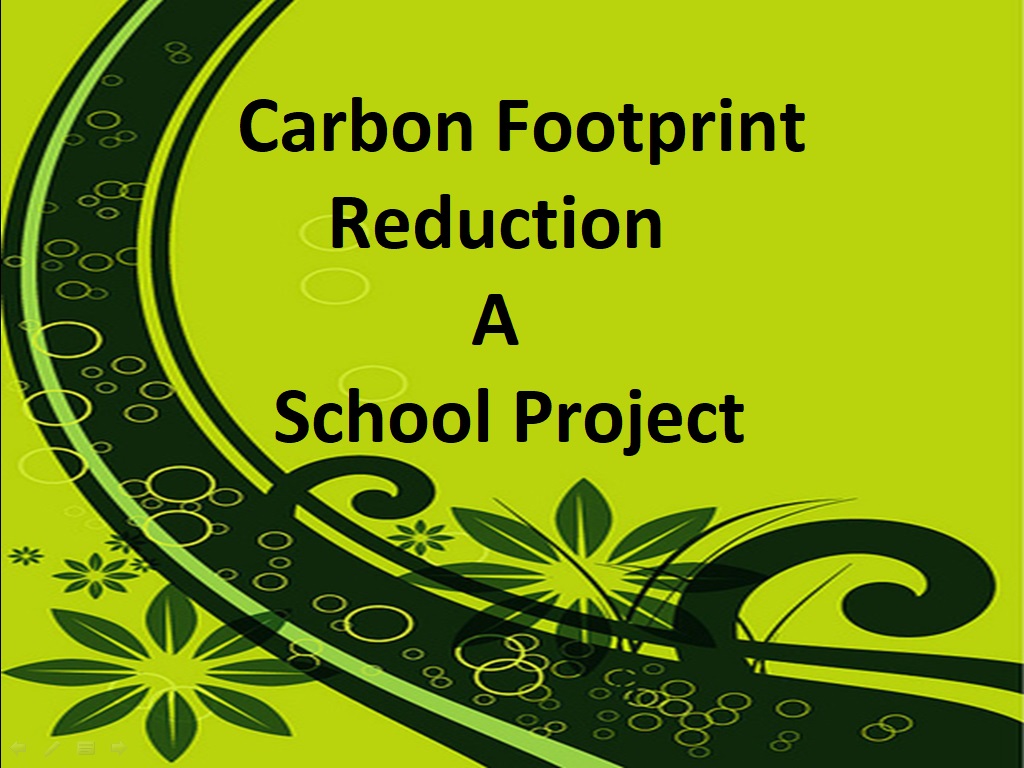Carbon Footprint Reduction: A School Project On a Greener Planet
Are you looking to make a positive impact on the environment and reduce your carbon footprint? Writing a school project on “Carbon Footprint Reduction” is a great way to learn about the importance of environmental sustainability and explore ways to make a difference.
In this project, you will delve into the concept of carbon footprints, which refers to the amount of carbon dioxide and other greenhouse gases emitted through human activities. By researching and understanding the impact of our actions on the environment, you can identify effective ways to reduce your carbon footprint and contribute to a healthier planet.
Through this project, you will not only gain knowledge about the global issue of carbon emissions but also learn practical solutions for living more sustainably. So dive into the world of carbon footprint reduction and discover how you can play a part in protecting our environment for future generations.
Carbon Footprint Reduction: A School Project On a Greener Planet
Aim Of The Project:
The aim of the project is to learn the importance of reducing carbon footprints and finding ways to actively contribute to a healthier planet.
Specific Objective:
The major objective of this project is to learn and raise awareness about the harmful effects of carbon emissions on the environment.
Also to encourage people to take action to reduce their carbon footprints.
By doing this project, we will have the opportunity to learn about the global impact of carbon emissions.
Also, learn about the various ways to reduce our carbon footprints in our daily lives.
Abstract / Acknowledgement
Acknowledgment: (what should be written) See an example below.
Acknowledgment
From the core of my heart, I (Your Name) am very thankful to everyone who supported me, to have completed my project on “Carbon Footprint Reduction” effectively and on time.
I am overwhelmed in all humility and grateful to acknowledge my depth to all those who helped me to put these ideas well.
Equally grateful to my (NAME OF SUBJECT TEACHER) for giving me moral support and guidance in doing this project.
It would be an injustice if I did not thank my parents who helped me a lot in collecting data, pictures, and continuous help and support.
With their guidance, encouragement, and support, I could complete my project on time.
Thanking you,
( Name of the student)
Carbon Footprint Reduction: A School Project On a Greener Planet
Introduction:
Our world is becoming increasingly aware of the importance of sustainability and environmental conservation.
Schools are taking on the responsibility of educating the next generation on ways to reduce their carbon footprint.
One such project our school recently undertook was centered around the theme of Carbon Footprint Reduction.
The topic of carbon footprint reduction is crucial in today’s world.
We are facing the challenges of climate change and its global impacts.
Our project focuses on educating students on the various ways in which they can decrease their carbon footprint.
This project is to explore the different aspects of their daily lives that contribute to their carbon footprint.
From transportation choices to energy consumption, we will uncover the ways in which our actions impact the environment on a global scale.
The purpose of this project is to bring small changes.
By making simple adjustments to our habits and choices, we can collectively make a significant difference in reducing our carbon footprint.
As we continue to do this project and inspire others to take action, we hope to see a ripple effect of positive change in our community.
Let us all be more mindful of our impact on the environment and work towards a cleaner, greener future for generations to come.
Carbon Footprint Reduction: A School Project On a Greener Planet
Ways To Decrease the Carbon Footprint Reduction:
Renewable Energy Adoption in Residential Areas:
Renewable Energy Adoption in Residential Areas can reduce our carbon footprint.
One effective way to do so is through the adoption of renewable energy in residential areas.
By incorporating solar panels, wind turbines, or geothermal heating systems, you can significantly decrease your carbon emissions.
Even at a local school, a group of students and teachers can transform their campus into a sustainable, eco-friendly community.
Through the implementation of solar panels, and energy-efficient appliances, the school can reduce its carbon footprint by over 50%.
The project will not only have a positive impact on the environment but also serve as a valuable learning experience for the students involved.
They will learn about the benefits of renewable energy, the importance of conservation, and the power of collective action.
The teachers can educate their students about global environmental issues and empower them to make a difference in their communities.
Therefore, there are countless ways to reduce your carbon footprint through renewable energy adoption in residential areas.
With this school project, we can all work together to create a greener, more sustainable future for generations to come.
Carbon Footprint Reduction: A School Project On a Greener Planet
Sustainable Transportation Solutions:
In today’s world, reducing our carbon footprint has never been more important.
With climate change looming as a global threat, it is crucial for individuals and communities to take action to lessen their impact on the environment.
One of the most effective ways to do this is through sustainable transportation solutions.
By opting for eco-friendly modes of transportation, individuals can significantly reduce their carbon footprint.
These alternatives will not only help to decrease emissions and pollution but also promote a healthier lifestyle and reduce reliance on fossil fuels.
In addition, advancements in technology have led to the development of electric vehicles (EVs) and hybrid cars.
These offer an even greener alternative to traditional gasoline-powered cars.
By choosing to drive an EV or hybrid, individuals can drastically decrease their carbon emissions and contribute to a more sustainable future.
Another aspect of sustainable transportation is the implementation of infrastructure that supports alternative modes of transportation.
For example bike lanes, sidewalks, and public transit systems.
By investing in these initiatives, cities can encourage more people to choose sustainable transportation options.
Energy Efficiency in Buildings:
1. The importance of reducing our carbon footprint through energy efficiency in buildings cannot be overstated.
Buildings account for a significant portion of carbon emissions worldwide, making it crucial for us to take action in order to combat climate change.
2. One of the most effective ways to reduce our carbon footprint is by making our buildings more energy efficient.
This can be achieved by installing energy-efficient appliances, using LED lighting, and properly insulating our homes and offices.
3. By reducing the amount of energy that our buildings consume, we can lower our overall carbon emissions.
This will not only benefit the environment but also help to cut down on energy costs for homeowners and businesses.
4. Investing in energy efficiency upgrades for buildings is a win-win situation for everyone involved.
Not only does it help to protect the environment and save money on energy bills, but it also creates jobs in the green energy sector.
5. If we all do our part to reduce our carbon footprint through energy efficiency in buildings, we can make a significant impact on the fight against climate change.
It is up to each and every one of us to take action and make a difference for the sake of our planet and future generations.
Waste Management and Recycling Initiatives:
Opt For Composting:
Start composting your organic waste at home to reduce methane gas emissions from landfills.
By turning waste into nutrient-rich soil, you can help reduce your carbon footprint while also improving soil quality in your garden.
Donate or Sell Unwanted Items:
Instead of throwing away items you no longer need, consider donating them to charity or selling them online.
This not only reduces waste but also promotes a circular economy where items are reused and recycled instead of ending up in a landfill.
Use Reusable Products:
Cut down on single-use plastics by investing in reusable products such as water bottles, coffee cups, and shopping bags.
This simple switch can significantly reduce the amount of waste ending up in landfills and help lower your carbon footprint.
Support Local Recycling Programs:
Educate yourself on what can and cannot be recycled in your area and make an effort to properly sort and dispose of your waste.
Supporting local recycling programs can encourage more sustainable waste management.
Moreover, such practices reduce the overall carbon emissions associated with waste disposal.
Reduce Food Waste:
Finally, plan your meals. Buy only what you need.
Store food properly to avoid unnecessary waste.
By reducing food waste, you not only save money but also help decrease the amount of methane gas produced in landfills.
Get creative in the kitchen by finding ways to use up leftovers and scraps to minimize waste.
Carbon Footprint Reduction: A School Project On a Greener Planet
Sustainable Agriculture Practices:
Sustainable agriculture practices are not only beneficial for the environment but also for our health and the economy.
Here are five ways you can make a difference through your everyday food choices:
Choose organic and locally sourced produce:
By supporting local farmers who use sustainable practices, you can reduce the carbon emissions associated with transporting food long distances.
Moreover, Organic farming also avoids the use of harmful pesticides and chemicals that contribute to air and water pollution.
Compost kitchen scraps and yard waste:
Instead of sending food and yard waste to the landfill, create your own compost to enrich the soil in your garden..
Plant a Garden:
Growing your fruits and vegetables or joining a CSA helps reduce the energy and resources required for industrial farming.
Plus, you’ll know exactly where your food comes from and how it was grown.
Reduce Meat Consumption:
Animal agriculture is a major contributor to greenhouse gas emissions.
Therefore, cutting back on meat and dairy products can significantly decrease your carbon footprint.
Opt for plant-based proteins like beans, lentils, and tofu to lower your environmental impact.
Using Sustainable Farming Practices:
Use sustainable farming practices in your own garden:
Implement techniques like crop rotation, companion planting, and water conservation to promote healthy soil.
Reduce the need for synthetic fertilizers and pesticides.
By practicing sustainable agriculture in your own backyard, you can contribute to a healthier planet for future generations.
Carbon Footprint Reduction: A School Project On a Greener Planet
How Renewable Energy is Transforming Our Carbon Footprint
Rise of Renewable Energy Sources
The rise of renewable energy sources such as solar, wind, and hydropower is drastically reducing our reliance on fossil fuels, which are major contributors to greenhouse gas emissions.
By switching to clean energy sources, we are effectively decreasing our carbon footprint and mitigating the negative impacts of climate change.
Technological Advancements
Renewable energy technologies are becoming more efficient and cost-effective, making them a viable alternative to traditional energy sources.
As more countries invest in renewable energy infrastructure, the shift towards a sustainable and low-carbon future becomes more achievable.
Investing in Clean Energy
The adoption of renewable energy is not only beneficial for the environment but also for the economy.
By investing in clean energy technologies, countries can create new job opportunities, spur innovation, and reduce their dependence on imported fossil fuels.
The transition to renewable energy is not just a necessity for combating climate change, but also a promising opportunity for economic growth and sustainable development.
Carbon Footprint Reduction: A School Project On a Greener Planet
The Power of Recycling in Carbon Footprint Reduction
Waste Not, Want Not:
Recycling plays a crucial role in reducing the amount of waste that ends up in landfills, which emit harmful greenhouse gases.
By reusing materials instead of creating new products from virgin resources, we can significantly decrease our carbon footprint.
Wonder of the Circular Economy:
Recycling is a key component of the circular economy, where materials are continually reused and regenerated.
This system reduces the need for new raw materials and energy, ultimately lowering carbon emissions and preserving natural resources.
Small Changes, Big Impact:
Every piece of paper, plastic, or metal that we recycle makes a difference in the fight against climate change.
By incorporating recycling into our daily habits, we can collectively make a significant impact on reducing our carbon footprint.
Carbon Footprint Reduction: A School Project On a Greener Planet
Sustainable Transportation Solutions for a Greener Planet
Electric Vehicles: The Future of Sustainable Transportation
The rise of electric vehicles (EVs) has been a game changer in reducing carbon emissions and combating climate change.
By using electricity instead of gasoline, EVs produce zero tailpipe emissions, making them an environmentally friendly option for daily commuters.
With advancements in technology and infrastructure, EVs are becoming more accessible and affordable, leading to a greener future for transportation.
Public Transportation: A Cost-Effective and Eco-Friendly Choice
Utilizing public transportation systems like buses, trains, and subways.
These are not only cost-effective options, but also a sustainable solution for reducing greenhouse gas emissions.
By opting for public transportation over individual cars, we can collectively decrease traffic congestion and air pollution.
Biking and Walking: An Active Approach to Sustainable Transportation
Embracing active modes of transportation like biking and walking not only reduces our carbon footprint, but also promotes a healthier lifestyle.
By incorporating these activities into our daily routines, we can reduce our reliance on fossil fuels and decrease our impact on the environment.
Additionally, biking and walking infrastructure in cities are making these modes of transportation safer and more accessible for everyone.
Carbon Footprint Reduction: A School Project On a Greener Planet
How Sustainable Agriculture Can Lower Carbon Emissions
Implementing regenerative farming practices
Firstly, implementing regenerative farming practices can help sequester carbon dioxide from the atmosphere and store it in the soil.
By using cover crops, crop rotation, and reduced tillage, farmers can improve soil health and capture carbon, ultimately lowering overall carbon emissions.
Synthetic Fertilizers and Pesticides
Sustainable agriculture focuses on reducing the use of synthetic fertilizers and pesticides.
These are often produced using energy-intensive processes that generate high levels of carbon emissions.
By transitioning to organic and alternative methods of pest and weed control, farmers can significantly decrease their carbon footprint.
Livestock Production
Livestock production is a major contributor to global greenhouse gas emissions.
This is mainly through methane production from enteric fermentation in ruminant animals.
Sustainable agriculture practices such as grazing, and improving feed quality, can help reduce these emissions and promote more eco-friendly farming methods.
Natural Ecosystems and Biodiversity
Sustainable agriculture also emphasizes the importance of preserving natural ecosystems and biodiversity.
They play a crucial role in sequestering carbon and mitigating the effects of climate change.
By protecting and restoring native habitats, farmers can contribute to a healthier environment and lower carbon emissions in the long run.
Research and Innovation
Lastly, by investing in research and innovation.
With this, we can create a more environmentally friendly food system that prioritizes the health of our planet and future generations.
Lowering carbon emissions through sustainable agriculture is not only possible, but essential for achieving a more sustainable and resilient future for all.
Carbon Footprint Reduction: A School Project On a Greener Planet
Conclusion:
There are many creative ways in which students can contribute to reducing carbon footprints, such as carpooling to school, using energy-efficient appliances, and participating in recycling programs. In this way, by implementing these simple changes, students can make a significant difference in reducing carbon emissions and protecting the environment for future generations.
So, if you are passionate about saving the planet and making a positive impact on the world, consider getting involved in the school project on “Carbon Footprint Reduction.” Together, we can work towards creating a healthier planet for all!
Ultimately, reducing our carbon footprint through sustainable transportation solutions is a win-win for both the environment and our own well-being. By making conscious decisions to prioritize greener modes of transportation, we can all play a part in creating a more sustainable future for generations to come.





0 Comments